Servicios Personalizados
Revista
Articulo
Indicadores
Compartir
Psicologia Escolar e Educacional
versión impresa ISSN 1413-8557
Psicol. esc. educ. v.11 n.spe Campinas dic. 2007
ARTICLES
Adapted design of multimedia-facilitated language learning program for children with autism
Modelo adaptado de programa de aprendizagem em linguagem facilitada por multimídia para crianças com autismo
Modelo adaptado de programa de aprendizaje en lenguaje facilitado por multimedia para niños con autismo
Fai-Kim Lau; Allan H.K. Yuen; John M-G. Lian
University of Hong Kong
ABSTRACT
The aim of this pilot study is to help researchers construct an appropriate multimedia-supported learning program for students who have autism. The results of this pilot study assisted the multimedia learn program designers to pay attention to the need of the development of a clear and simple layout, multiple level of content presentation, and simple but direct audio instructions. The core conclusion is the significance of the need for caring individual differences of these students during the learn process.
Keywords: Technology, Learning, Autism.
RESUMO
O objetivo desse estudo é de ajudar os pesquisadores a construir um programa multimídia de aprendizado adequado para estudantes com autismo. Os resultados desse estudo piloto auxiliarão aos programadores de programas de aprendizagem em multimídia a ficarem atentos à necessidade de desenvolverem um padrão simples de paginação, diferentes níveis para apresentação de conteúdo e instruções orais simples e diretas. A principal conclusão refere-se à importância de atender às diferenças individuais destes estudantes durante o período de aprendizagem.
Palavras-chave: Tecnologia, Aprendizagem, Autismo.
RESUMEN
El objetivo de este estudio es ayudar a los investigadores a construir un programa multimedia de aprendizaje adecuado para estudiantes con autismo. Los resultados de este estudio piloto auxiliarán a los analistas de programas de aprendizaje en multimedia a estar más atentos a la necesidad de desarrollar un padrón simple de paginación, diferentes niveles para presentar el contenido e instrucciones orales simples y directas. La conclusión principal se refiere a la importancia de atender a las diferencias individuales de esos estudiantes durante le período de aprendizaje.
Palabras clave: Tecnología, Aprendizaje, Autismo.
Theory Framework
We adopted a cognitive perspective of information processing theory in multimedia learning (Lau, 2005; Lau, Yuen & Lian, 2006) based on the definition of information processing (IP) as a joint product of information theory and computer sciences (Alessi & Trollip, 2001). Secondly, the explanation of IP's specific characteristics (Massaro & Cowan, 1993) may be able to explain and contribute to the progress of vocabulary learning in students with autistic features. Thirdly, our essential source includes the ideas and findings of Robert E. Kozma (1987, 1991) and his associates (Kozma & Croninger, 1992) and of Richard E. Mayer (2001).
Our initial assumption was that weaker expressive performance in children with autism was an outcome of delayed development in the ability of their working memory (WM) retrieving corresponding visual and audio information to their long-term memory (LTM) as Bird, Castelli, Malik, Frith & Husain described (2004). In other words, the speech difference of children with autism than their typically developed counterparts is likely a neuro-physiological problem. Hence, this inevitably limits their speech performance.
With reference to Levelt's (1989) application of IP theory to speech formulation in human learning, we hypothesized that such a language learning gap in children with autism might be bridged theoretically with a variety of processing qualities displayed in the procedure system. Modified from Kozma and Mayer's multimedia learning theory, in which multimedia presentation is a crucially essential symbol system, and based on Massaro & Cowan, (1993), we assumed automaticity and interactivity, two key features of computer-based multimedia programme, able to help students with autism develop their spoken vocabularies acquisition. The graphic titled like Figure 20 shows this schema.
In our framework, students with autism act as a processor able to interact with humanized multimedia programme and computer technology (Mayer, 1996). The second significant feature is the automatic functioning of computer-based multimedia system able to lessen or eliminate children with autism's distraction (Hardy, Ogen, Newman & Cooper, 2002). That means automaticity of computer acted as a trigger in activating information retrieval from the LMT. For example, auto run of the programme and auto record of subjects' data are able to serve this purpose.
The third component is the multimedia system as an external memory (Kozma & Croninger, 1992). As described earlier, possibly only visual information retrieved from short-term memory to long-term memory. Therefore, in the learning process, we would record participants' verbal expressions that may help them to recall full information of information stored in previous session.
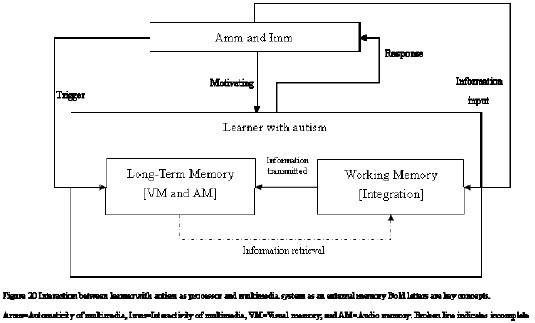
The last but not the least is the adoption of the concept of leaning ecology in which this kind of learning tool performs its role and function (Cobb, Confrey, diSessa, Lehrer & Schauble, 2003). That means we consider as many as possible the relevant observable and hidden personal and contextual factors significant to their mutual relationships affecting each participant's changes.
In order to have a relatively comprehensive understanding about the reaction of children with autism to a computer-based multimedia learning programme, we conducted a two-week pilot study. We expected the findings be able to help us construct an original and appropriate programme for our subjects in the main study. Information collected during the pilot study would also help us design an adaptive pedagogy for those children who were diagnosed with autism. This paper reports some insights generated from the pilot study.
Autism is one the pervasive developmental disorders (DSM-IV). Weak verbal performance is one of the typical features in persons with autism (Scott, Clark & Brady, 2000; Wetherby, Prizant & Schuler, 2000). However, rapid technological development, especially that of information and communication technologies, in past decades have provided means to assist individuals on the autistic spectrum to develop their speech (Hetzroni & Tannous, 2004; Kinney, Vedora & Stromer, 2003; Massaro & Bosseler, 2006; Mirenda & Erickson, 2000). Therefore, we pioneered a study in Hong Kong exploring the prospective changes in verbal vocabulary acquisition in children with autism and limited speech in a multimedia-facilitated context.
Method
A speech therapist (ST) of a local special school other than our target school of the main study administered and coordinated our pilot study.
Participating students had similar autistic behavior to those of the school in our main study.
Participants
Three boys from 7 to 8 in their chronological age but in their language age of 2; 09 to 3; 10 were selected. Their IQ levels were round about 60 to 66. Educational psychologists or clinical psychologists in representative and authoritative organizations such as the Education and Manpower Bureau (EMB) or Duchess of Kent Hospital Child Assistance Centre conducted the language and mental assessments and diagnosed these children as autistic with global developmental delay or pervasive developmental disorder. The tools included Griffiths Mental Developmental Assessment and Reynell Developmental Language Scale (Cantonese version). These took place two years before this pilot study. There seemed no follow-up tests but we believed that these boys should have made certain progress in this period of schooling. Their parents are native Cantonese speakers who are dominant population in Hong Kong.
Assessment tool
There was no existing technology-facilitated language learning programme catering for students with autism in local market but a commercial product for kindergarten at level 2 was available. Hence, we examined carefully this interactive multimedia learning programme by a local renowned publisher before we used it.
First, its game-oriented design with multi-level presentation was essentially significant. That is, vocabularies represented in verbal, graphic, and character formats, were able to help the boys concentrate on the tasks. We likely applied these techniques to our self-developed programme. Second, the layout, style of presentation, and topics in the curriculum were able to arouse these boys' interests.
Third, although the product catered for children of 4-5 years old in Hong Kong, the designers included merely simple single-character vocabularies that the boys should have no difficulty in recognition and understanding. Further, we selected topics closely matched with the participants' ability and related to their life experiences, including family life, transportation, and supermarket. We also chose topics on spring and winter because we started the study in early February.
Having these considerations, we made use of the given activities to assess the boys in four areas: matching, making choice, putting to the right location, and observing rules.
Matching activities
The first six matching tasks required students to select appropriate character to represent the picture shown (Figures 1 and 2). The second two matching tasks asked students to complete a picture with given graphics (Figures 3 and 4).
Making choice activities
A narrator in two tasks of the game about making choice between two objects asked students to click on an object, for example, "which one is hot?" (Figure 5) They would get marks if making a correct choice.
Right location activities
Figures 6 and 7 are about the game asking students to relocate transportation means. The children just clicked on the misplaced graphics that would appear on the appropriate location.
Observing rules activities
The task asked for a correct choice of signs. Figure 8 shows a rule of no-tricycle on the playground crowded with children. Figure 9 shows a rule of not kicking ball inside the pavilion.
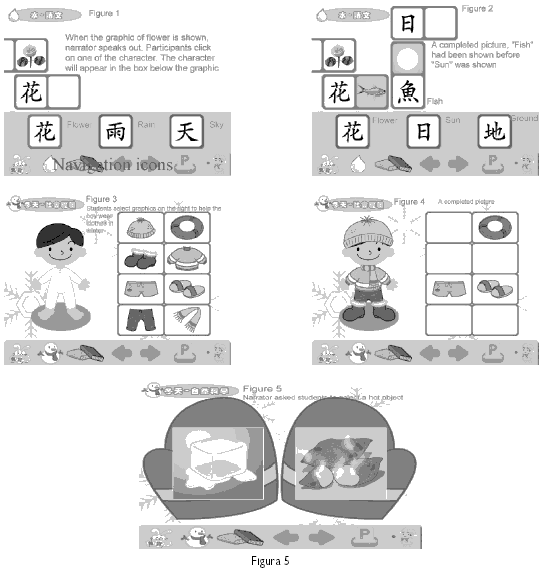
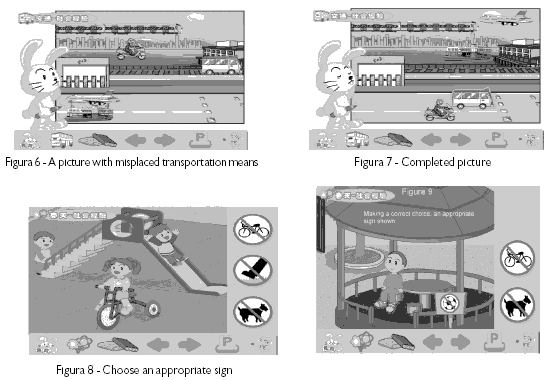
Despite twelve tasks available, students were free to finish as many as they could do and/or felt interested in. We chose these games mainly because they were identical with the boys' mentality and were the hot topics school teachers taught in whatever type of schools in Hong Kong. The rule observation task might be slightly difficult for some children with autism, but we anticipated that this challenge would serve as a motivation agent and was productive. In fact, we always kept in mind not to overestimate or underestimate the actual ability of each child.
Procedure
The boys had equally six 30-minute sessions, same duration in our main study, within two weeks. The interaction was in face-to-face and person-to-person mode and took place in a conference room at the top floor of the school building. Hence, the researcher picked one of them up each time and led him to the venue. On the way, the researcher usually initiated a purposeful conversation, intending to build up a rapport between both parties and to have a deeper understanding about each of them.
Our principal investigator, who had six-year teaching experience with children special educational needs including autism, was aware of the possible difficulty in understanding the narration embedded in the software with that the boys might not be familiar. He either rephrased the narration with appropriate wordings, or demonstrated how to complete the task. His duties also included tape-recording, guiding and playing with the children, observing their behaviour, managing some unexpected incidences and so on. In other words, he was the sole facilitator in each session.
In order to minimize the effect of some unexpected and/or aversive behaviors because both researchers and these children with autism were very new to each other, we accepted ST's advice to prepare two sets of play kits and some snacks. Her advice in fact reflected an on-going practice in this school. Being realistic, external reinforcement might serve as some kind of channels for their cooperation in so limited contact time. The play kits that they used to play might also pacify their emotions when they became unstable. In other words, we actually considered the school culture and some unique characteristics of children with autism in Hong Kong.
At times, there was no interference with the boys' behavior or participation in the conference room. The more natural their reaction, the more valuable and helpful information about learning styles and strategies by children with autism would be. Their performances were video-recorded for analysis too.
Results
Based on the analysis of students' video-taped performance, the outcomes did help us confirm the need for an adapted design of our self-developed learning software, for example, the effect of simple layout. Some of the boys' performances confirmed our ideas while some helped consolidate our plan and way of thinking, for instance, the relationship between students' need for materialistic rewards and their need for care.
In this section, we will categorize the findings of this pilot study in five essential areas including students' performances, knowledge of vocabularies, communication with facilitator, reinforcement, and individual differences. We will associate the description with our programme design for our subjects in the main study in next section.
Students' performances
P1 showed consistent interest in the programme. He did not interrupt the programme and stayed to work alone without distraction even when the researcher was away for a while. The boy was able to manage the games, to have clear concepts of categories, and to get very high marks in all completed tasks in each session. Good results excited him obviously. The boy's high level of concentration exhibited his interest in the themes of the programme. He likely had no difficulty or problem in computer games or tasks. Despite a commercial product, this educational programme's design, including architectural and curriculum, seems appropriate for this boy.
Contrast to P1's performance, P2 expressed unstable interest in the programme. Sometimes, he was inactive but showed involvement in certain tasks especially when he was rewarded with the snacks. For example, he did a very good job in the item of winter. He even spoke out "scarf" and "thank you" after prompting and expressed verbally his desire in single words. In other instances, he might play with or touch the mouse when requested to play a game matching a picture with the appropriate word but no reinforcement given.
P3 exhibited his strong control desire on the programme and devices. He fetched the mouse immediately after sitting at the computer desk in the first day but switched off the computer when the programme just started. In the following days, he appeared attentive, showed more positive interest in the programme, and was able to accomplish the tasks but he might suddenly shift to another topic. After exiting the programme, he would re-enter the programme and tried again but might exit again. He was cheerful after task completed but shortly he began to move showing his impatience. In fact, he exhibited more interested in changes in tasks, for instance, pressing icons, shifting topics from one to another, going outside the room and the like, instead of focusing solely on one task.
Regarding attitude to the scores, P1 smiled when he tried successfully and got high scores. P2 seemed not interested in the marks and might lean back to the chair. His initiative was overall weak. P3 showed his ability in the tasks. Nevertheless, his non-verbal signals expressed such message, "I do not care the score".
To P3, some built-in exciting sound seemed attractive but likely not in other two boys. In the process, P2 did not quite understand the audio instructions of the programme because he stopped and withdrew sooner he attempted with no choice made. There may be some hidden difficulty in P1 and P2's motor skills because they sometimes needed researcher's help, particularly P2.
All in all, P1 showed an overall positive attitude to this commercially designed educational learning programme and performed very satisfactorily. The obvious unstable reactions to the programme displayed in P2 and P3 alerted us in the design of our self-devised programme, especially on layout, presentation, and audio instructions. We will discuss these and other relevant topics in later part of this paper.
Knowledge base of vocabularies
Various speech performances demonstrated different knowledge bases of vocabularies in P1, P2, and P3. P1's receptive and expressive performance appeared the best among the three. He was able to express his need verbally at intervals and to respond with fairly complex vocabularies and statements. For example, he replied, "Short pant is for summer" when asked if people wore short pant in winter. To respond a question about hot items, P1 elaborated what he saw, saying "sweet potatoes are hot". He also was able to use such expressions as "Put the schoolbag", "electric cooker" or words for location, for example, "Here", "On desk top". On the way to the conference room, this boy described what he just saw and tried to explain why some incidence happened. Sometimes, he made request and/or raised question.
P2 was able to speak simple vocabularies, for example, "yes", "cup", and to point at the characters "people", "bed" without speaking them out. He apparently had better receptive ability than his performance in verbal expression. He frequently made some sound to express his needs and/or emotions.
Like P2, P3 seldom talked but was found able to speak such expressions as "Good" and even some complex statements like "Yes, I do want to eat!" In second session, this boy did try on the game and he knew most of the items. He was able to respond, "Thank you" when asked what he had to say in receiving gift. Occasionally, the boy was able to ask questions, for example, "Where is this?"
Communication with facilitator
All three boys were capable of understanding researcher's instructions and requests. P1 followed facilitator's instructions or the programme narrator's step by step but required cuing and verbal explanation in certain situations. P2 showed no response to researcher's appreciation while he accepted researcher's help to point at his choice of answer.
Demonstrations seemed essential in this boy. His performance apparently declined if solely relying on audio instructions.
P3 expressed kinetically his clear reluctance to follow researcher's intervention. His unexpected good performance in Day 4 was likely the result of free navigation. He usually made little response to the researcher's request, instruction, explanations, and/ or questions.
In some other instances, each of them showed some particular communicative needs. P1 once felt interested in the researcher's forehead without hair and touched on researcher's head top. At intervals, P2 shut his ears with his hands, or curled up in the chair, or turned half of his back to the researcher. At the end of the first session, this boy shook hand with the researcher and scratched slightly and softly on the latter's hand.
Very firm, clear, and direct instruction from authoritative figures appeared crucial in P3's learning. His highly cooperative attitude in second day resulted in his class teacher's serious warning. However, his desire of control manifested this boy's expectation of doing things on his own. He pulled researcher's hand away when closing the programme, and struggled with the researcher to get back the mouse. When the researcher insisted to holding the mouse, the boy started to gape and to press the keyboard.
Reinforcement
P1 appeared less aware of the existence of materialistic reward for tasks completed although he also was happy to receive snacks. Contrarily, P2 expressed impatience and irritation when keeping him to wait for a considerable time to the promised snacks for correct answers. This may show that materialistic reinforcement was significant and encouraging for P2. In some instances, P3 turned his head back looking for the snacks if he wanted.
Interesting to note is the use of alternative reinforcement. P2's better performance as described in earlier part of this section demonstrated a shift from single materialistic reward to a mixed mode. P2 got his reward for a right choice resulted in his expressed desire to complete the task.
In P3's case, researcher made an oral contract with him and allowed him to sightsee outside the conference room if he was able to finish certain tasks. Another motivator was the play with puzzles. Researcher promised to set some time for this activity before or after P3 also kept his promise to complete the task. Results in Day 4 and Day 6 seemed to support the success of these tactics. Significance of reinforcement, whether materialistic or symbolic, extrinsic or intrinsic, was obvious.
Individual differences
Findings above disclose the unique features of individual students. P1 was more obedient than the other two boys were and his language level was obviously superior to that of P2 and P3. For the latter, P2 showed his significant need for substantial reinforcement but he also considered free decision-making an essential need, which was part of P3's characteristics as well. More obvious, nevertheless, was P3's preference about changes in tasks. This confirmation on individual differences will inevitably assist us to construct an appropriate multimedia design for our main study. We are going to elaborate this in next section.
Discussion
Results reported above reflect the potentials of using multimedia software to help language learning in children with autism (Moore, & Taylor, 2000; Tjus & Heimann, 2000). Hence, we started our programme design to suit interests of students with autism immediately after the pilot study.
Below is a concise discussion about the impact of findings in preceding section on our design in three dimensions: multimedia design, pedagogical approaches, and theoretical framework. The discussion on multimedia design includes interfaces and curriculum and is closely related to students' performances and knowledge base of vocabularies and that about pedagogical approaches covers reinforcement, facilitator, and need for caring for individual differences. Both in turn are associated with the communication style of students with autism.
First, this is a question of catering for individual differences we highlighted in the section about students' performances. Second, the effect of communication style reflects if the designer expects interaction between the learner with autism and the multimedia programme, that is, her level of activity or passivity. Third, this is equally essential or even more crucial that a facilitator is able to fully aware of her or his role in the language learning process. In this sense, we have to consider if the facilitator solely rely on the multimedia programme without authentic interaction with her or his learners.
Multimedia design: Interfaces
Layout
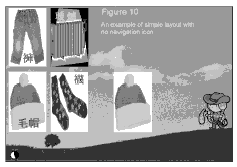
Observing the significance of a simple layout in a piece of multimedia software for students who have autism, we deliberately gave up sophisticated navigation layouts that were too easily to distract the participants' attention. Figure 10 shows an example of a simple and clear layout that there was no specific navigation icon. The subjects in our main study would have to finish all required tasks before automatic entering another page of task. Therefore, a number of tries for each task and time for each try were set.
However, we kept free navigation between these activities because repetition is imperatively essential for students who have autism. Another purpose was particularly for those who were able to skip one task. The commercial product we used in the pilot study had such function too but she had several pages for a single activity. In order to maintain a simple design, we decided to group all icons for individual activities in one page.
Presentation
Considering the characteristic of relatively stronger visual ability in students with autism and an increase data retrievability (Kozma, 1987), we adopted two specific designs, use of background music and multiple level of presentation, resulted from P3's responses and the commercial educational interactive programme adopted in the pilot study. Samples in later section showed each vocabulary represented in text (traditional Chinese characters), graphics (corresponding pictures or animations), and built-in audio narration and/or pronunciation.
Login page
On the Main page (Figure 11), we displayed five portraits representing each of our subjects expecting to enhance their sense of involvement and then their motivation. Each subject would have an assigned login password (Login page) because this facility allowed a personal account for each child so that s/he could store pertinent data in the computer file for analysis in later stage.
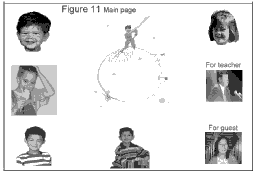
Use of a single digit numeric password, the easiest way for the subjects was to eliminate the difficulty in keying their names, school names, and class number as in the pilot study's product. Besides, we used portraits instead of personal photos because the subjects' photos were not available and, more significant, the consideration of confidentiality.
Audio instructions
One of the main reasons for not very satisfactory performances of two participants in the pilot might be the flow of the programme, particularly the audio instructions. The way of narration and instructing was appropriate for typically developing children, but this would not be easy for children with autism to follow. Although we were fully aware of this obstacle as explained in section 2.3, and the principal investigator rephrased, P2 and P3 might have been irritated and, therefore, were not able to concentrate on certain tasks. With this anticipation, all audio instructions and narrations in our original programme were brief and direct. In the title page of each activity, there also were written instructions in point form accompanied with graphics where appropriate (Figure 12).
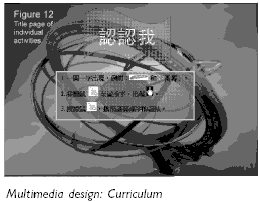
Multimedia design: Curriculum
Overview
Figure 13 presents a brief structure of the software in the main study. There were very brief explanations about each learning theme of five learning tasks and six games involving vocabularies of different classes and nature generated from the short story broadcasted in video format. Except two games which acted as relaxation agent, all learning tasks and games would have scores.
The ongoing assessments allowed us to understand any changes in the children's learning behavior including effect of certain vocabularies and instruction. A1 to A3 assessed number of successful and unsuccessful tries for vocabularies child had learnt in the intervention phase, class and nature of these vocabularies, time for each try, and the corresponding scores. Integration of these assessments with learning activities and free navigation among them allowed some subjects to have repeated chances to do a particular assessment. A4 was an assessment on the acquisition of the short story that each subject was required to read aloud the three statements in the story.
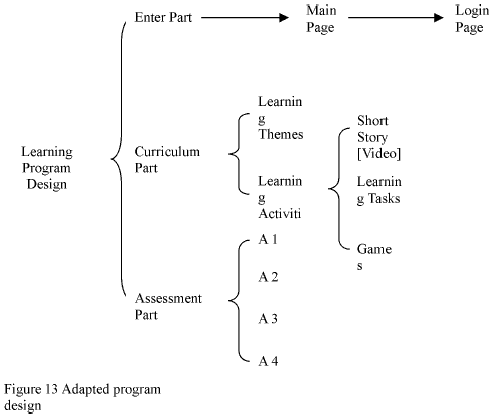
Contents
The boys' receptive and expressive performances in pilot study confirmed us to modify a well-structured but sophisticated language learning scheme of a reputable special school serving a mixed group of students with disabilities, including children with autism. We classified two sets of vocabularies, food and clothing, for our subjects into five categories: single, 2-vocabulary, 3-vocabulary, 4-vocabulary, and concept of category. These items primarily constituted the mainly body of the short story introduced in the preceding section. We also included some relevant items, whether learnt or fresh to our target subjects.
The unique features of Chinese language were a very important factor affecting our design. Take "fruit" as an example. In a game adapted from an English vocabulary learning website, the designer could split and mixed all alphabets of the word with other alphabets and asked the learner to rearrange the order and form the word again. However, in Chinese, "fruit" is composed of two different characters which themselves are single vocabulary. If we break the vocabulary "fruit" into a number of strokes, the task to re-form the vocabulary is too complicated and advanced for our subjects. Hence, we had to include other characters and asked the children to choose two characters among the set and move them to the circle box in proper order and form the required vocabulary ("fruit") (Figure 14).

Moreover, 3-vocabulary and 4-vocabulary in Chinese may be a statement or a sentence. This implies, therefore, a learner acquiring 3-vocabulary and 4-vocabulary statement or sentences has already manipulated the basic speaking skills in Chinese. In other words, an evaluation on a learner's 3-vocabulary and 4-vocabulary acquisition is more or the less the same as an assessment on her or his ability in putting those characters in systematic and proper order, that is, fundamental speech performance. With this understanding, we provided our subjects with all relevant 3-vocabulary and 4-vocabulary statements and their corresponding pictures. Then we spoke out these statements and asked the children to identify the right graphic.
Figures 15 and 16 show how students moved the characters of a 3-vocabulary statement to the proper boxes; then an audio statement "well done" appeared with written form. In expressive activity, they simply read those sentences which were audio-recorded to the computer files.
Figures 17 to 19 are about the receptive and expressive task for 4-vocabulary statements. Students identified the right picture according to the narrator; then an audio statement "well done" appeared with written form. In expressive activity, they did the same as the previous task for 3-vocabulary statements.
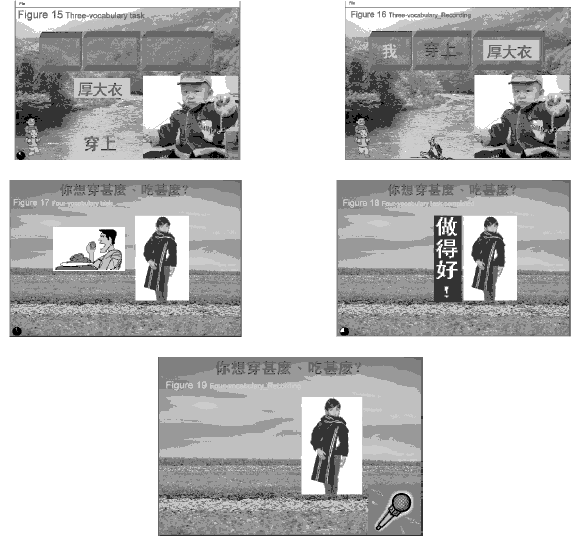
Pedagogical approach
Facilitator
In addition to the role of monitor and facilitator described in earlier section, the principal investigator had to face some imperative ad hoc events with learning implications during intervention phase of our main study as in the pilot study. P1 and P2's reaction and behaviour described in early part of this report posed challenges to special educators using multimedia-supported learning tool in the teaching process. We also need to solve the question: how to produce a product catering for this kind of users to navigate on her or his will. More accurate, this may involve teachers in general education of all levels.
Reinforcement
The two boys' expectation for whatever rewards discussed in preceding section may define the significant importance in the learning and teaching processes of students with autism. For example, in recent International Conference on Special Education held in Hong Kong, an attendee asked our principal investigator if materialistic reward was one of the factors motivating students with autism to learn. She also wondered if it should be part of and integrated with the pedagogical or instructional considerations. Her question was mainly a response to our report on our preliminary study.
Alternatively, we also observed effects of other means in reinforcement like enhancing P2's self-motivation and oral contract with P3. Surely, it was too quick and too early to have an immediate conclusion on the integration of concrete reward with pedagogical practices. It needs further investigation indeed. However, we did include substantial reinforcement mixed with playing toys in our main study because we observed the need for care in the pilot study.
Again, such need is to large extent related to one's history of growth and interrelationships of all environmental stimulations. In the design of appropriate learning software, we are facing the issue: how can we care for children with autism?
Need for caring for individual differences
We have discussed how different reinforcements in the pilot study related to pedagogical approaches motivating students with autism and how the facilitator effectively made use of this kind of relationship in various situations. Individual difference, nevertheless, between the three boys was the core in our concern. In the pilot study, we attempted to shift P2's attention to other issue by identifying his possible fear of the researcher and his explicit interest in the mouse. Then we drew his attention back to the initial item and assisted him to make a selection of appropriate answer for the task. For P3, our intervention approach changed slightly with the focus on various combinations of game activities and time for each task per session was deliberately shortened.
The boys' behaviour in the pilot study has demonstrated the necessary and essential impact of individual difference on curriculum design, instruction adaptation, and pedagogical adjustment. In fact, the concern of such difference exhibits the need for care. Since we care, we refined our methods in the process to match with the boys' cognitive needs, comparatively difficult interpersonal relationship, relatively shorter attention span, and weaker ability in decision-making. Simply speaking, in multimedia-support learning context, personal interaction and verbal explanation on activities is still significant.
Theoretical framework
In spite of the purpose of the pilot study described at the start of this report and different target population of the commercial product used, there were insights generated from the findings for our theory building in the main study.
The participants' performances in our pilot study seemed able to indicate the motivating function of a multimedia programme. P1's involvement and P2 and P3's unstable good performance likely supported the assumption that the visual information input was able to help them make appropriate responses.
However, the findings were not able to evidence positively or negatively the desirability of automaticity and interactivity of the multimedia software as initially expected in the learning process. P1 was the one expressing the highest level of interactivity with the programme among the three. However, we had no adequate supporting information to associate his involvement with what Hardy et al. (2002) argued that the automatic features might help reduce or minimize easy distraction in childhood autism.
Instead, P2 and P3 seemed to provide some behavioral indicators to a possible dissociation between the trigger effect of automaticity and developments in learning outcome. This may imply some connection of automaticity with other dimensions, e.g. the psychological and cognitive needs of the child, in the issue of distraction. This in turn relates to the relevancy of information to the children with autism's functioning (Swanson, 1987). In other words, some other equally significant factors, for example, efficient use of cognitive strategies (Kozma, 1987), closely related to individual characteristics of learners with autism may be overlooked. We need further exploration on whether automaticity and interactivity independent of these personal or contextual factors.
Some other reflections include the effect of integration of audio and visual data, the transmission process from working memory to long-term memory, and the retrieval process. All these require a second study to clarify their impact on the learning programme design.
Conclusion
The main theme of this paper is about the need for adaptation in technology-facilitated education. We have concisely discussed the insights from the performances of the three boys in our pilot study on programme design of our self-devised multimedia-supported learning tool, pedagogical or instructional modifications, and our theoretical framework.
In fact, the interaction of the boys with the commercial product reminds us not to confine multimedia design in the media themselves involving organization of learning and/or teaching material, the format of presentation, tasks to be completed, and the like. Multimedia software is better to serve as a cognitive tool as Kozma (1987) suggested. It may be one of the "adaptive learning systems [which] are learning programmes capable of adapting themselves to the individual abilities of the learner, e.g., previous knowledge, interests, weaknesses or preferences with regard to forms of representation" (Steinmetiz & Nahrstedt, 2004, p. 162). This is why Kozma (1991a) agreed that "such tools will be more effective if they activate the task-relevant cognitive skills that writers already have while they model and support those cognitive processes and skills the writers lack" (p. 35) when he explained the relationship between computer-based writing tools and the writers' cognitive needs.
By and large, an essential contribution of this pilot study is the confirmation of need of caring individual differences in whatever learning contexts.
References
Alessi, S. M., & Trollip, S. R. (2001). Multimedia for learning: Methods and development (3rd ed.). Boston: Allyn and Bacon. [ Links ]
Bird, C. M., Castelli, F., Malik, O., Frith, U., & Husain, M. (2004). The impact of extensive medial frontal lobe damage on 'Theory of Mind' and cognition. Brain, 127(4), 914-928. [ Links ]
Cobb, P., Confrey, J., diSessa, A., Lehrer, R., & Schauble, L. (2003). Design experiments in educational research. Educational Researcher, 32(1), 9-13. [ Links ]
Hardy, C., Ogden, J., Newman, J., & Cooper, S. (2002). Autism and ICT: A guide for teachers & parents. London: David Fulton. [ Links ]
Hetzroni, O. E., & Tannous J. (2004) Effects of a Computer-based intervention program on the communicative functions of children with autism. Journal of Autism and Developmental Disorders, 34(2), 95-113. [ Links ]
Kinney, E. M., Vedora, J., & Stromer, R. (2003). Computer-presented video models to teach generative spelling to a child with an autism spectrum disorder. Journal of Positive Behavior Intervention, 5(1), 22-29. [ Links ]
Kozma, R. E. (1987). The implication of cognitive psychology for computer-based learning tools. Educational Technology, 27(11), 20-25. [ Links ]
Kozma, R. E. (1991a). Computer-based writing tools and the cognitive needs of novice writers. Computers and Composition, 8(2), 31-45. [ Links ]
Kozma, R. E. (1991b). Learning with media. Review of Educational Research, 61(2), 10-23. [ Links ]
Kozma, R. E., & Croninger, R. G. (1992).Technology and the fate of at-risk students, Education and Urban Society, 24(4), 440-453. [ Links ]
Lau, F. K., Yuen, A. H. K., & Lian, M. G. J. (in press). Use of information technology in addressing learning styles to enhance language intervention with children with autism. In C. Forlin & M. G. J. Lain (Eds.), Reform, inclusion & teacher education: Towards a new era of special & inclusive education in Asia-Pacific regions. Hong Kong: University of Hong Kong Press. [ Links ]
Lau, F. K. (2005). Spoken vocabularies development in children with autism through multimedia-supported instruction. Research Studies in Education, 3, 136-153. [ Links ]
Lau, F. K., Yuen, A. H. K., & Lian, M. G. J. (2006). Enhancing spoken vocabulary performance in children with autism in a multimedia-supported context. Proceedings of the Hong Kong International Information Technologies in Education Conference (pp. 85-93). Hong Kong: Education and Manpower Bureau. [ Links ]
Levelt, W. J. M. (1989). Speaking: From intention to articulation. Cambridge, MA: MIT Press. [ Links ]
Massaro, D. W., & Bosseler, A. (2006). Read my lips: The importance of the face in a computer-animated tutor for vocabulary learning. Autism, 10(5), 495-510. [ Links ]
Massaro, D. W., & Cowan, N. (1993). Information processing models: Microscopes of the mind. Annual Review of Psychology, 44(1), 383-425. [ Links ]
Mayer, R. E. (1996). Learners as information processors: Legacies and limitations of educational psychology's second metaphor. Educational Psychologist, 31(3/4), 151-161. [ Links ]
Mayer, R. E. (2001). Multimedia learning. Cambridge, England: Cambridge University Press. [ Links ]
Mirenda, P., & Erickson, K. A. (2000). Augmentative communication and literacy. Autism spectrum disorders: A transactional developmental perspective (vol. 9, pp. 333-367). Baltimore, MD: Brooks. [ Links ]
Moore, D. J., & Taylor, J. (2000). Interactive multimedia systems for people with autism. Journal of Educational Media, 25(3), 169-177. [ Links ]
Scott, J., Clark, C., & Brady, M. (2000). Students with autism: Characteristics and instructional programming for special educators. San Diego, CA: Singular. [ Links ]
Steinmetiz, R., & Nahrstedt, K. (2004). Multimedia applications. Berlin: Springer-Verlag. [ Links ]
Swanson, H. L. (1987). Information processing theory and learning disabilities: A commentary and future perspective. Journal of Learning Disabilities, 20(3), 155-166. [ Links ]
Tjus, T., & Heimann, M. (2000). Language, multimedia and communication for children with autism- searching for the right combination. In S. Powell (Ed.), Helping children with autism to learn (pp. 78-93). London: Fulton. [ Links ]
Wetherby, A. M., Prizant, B. M., & Schuler, A. L. (2000). Understanding the nature of communication and language impairments. Autism spectrum disorders: A transactional developmental perspective (vol. 9, pp. 109-141). Baltimore, MD: Brooks. [ Links ]













 Correspondence to
Correspondence to